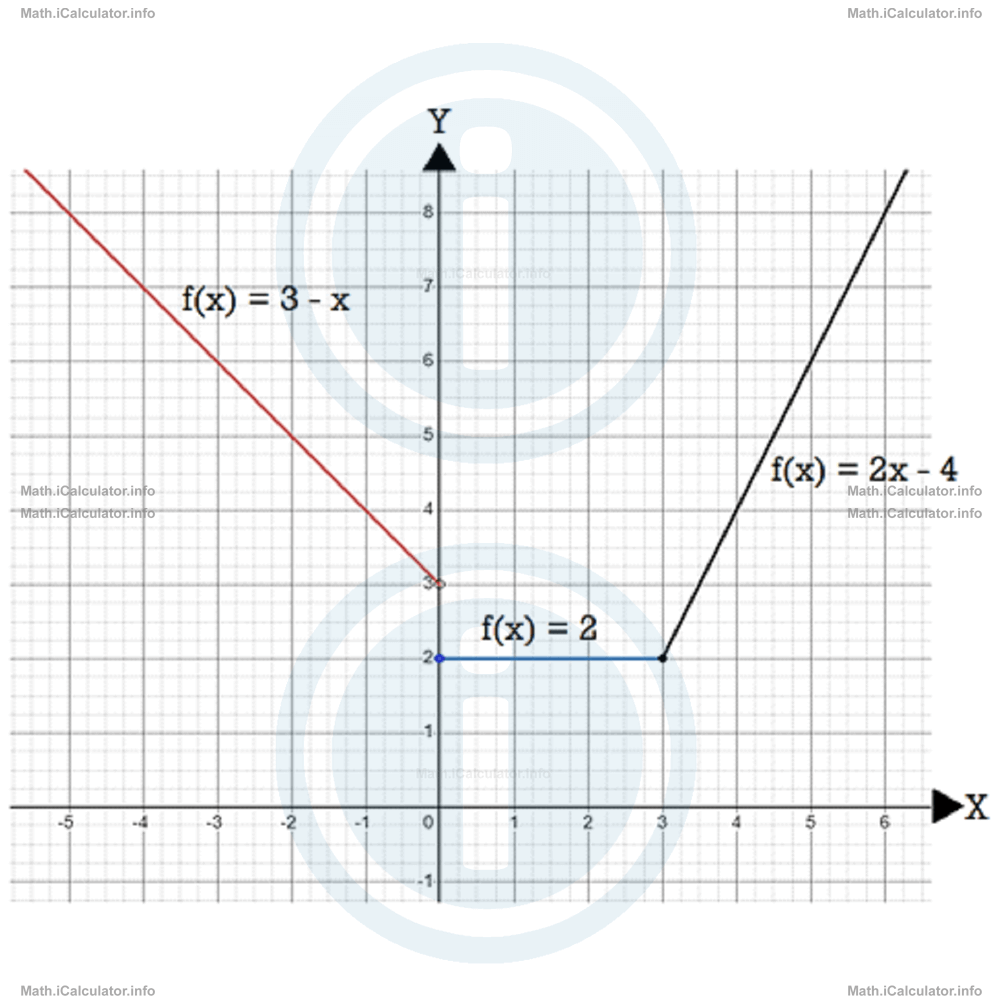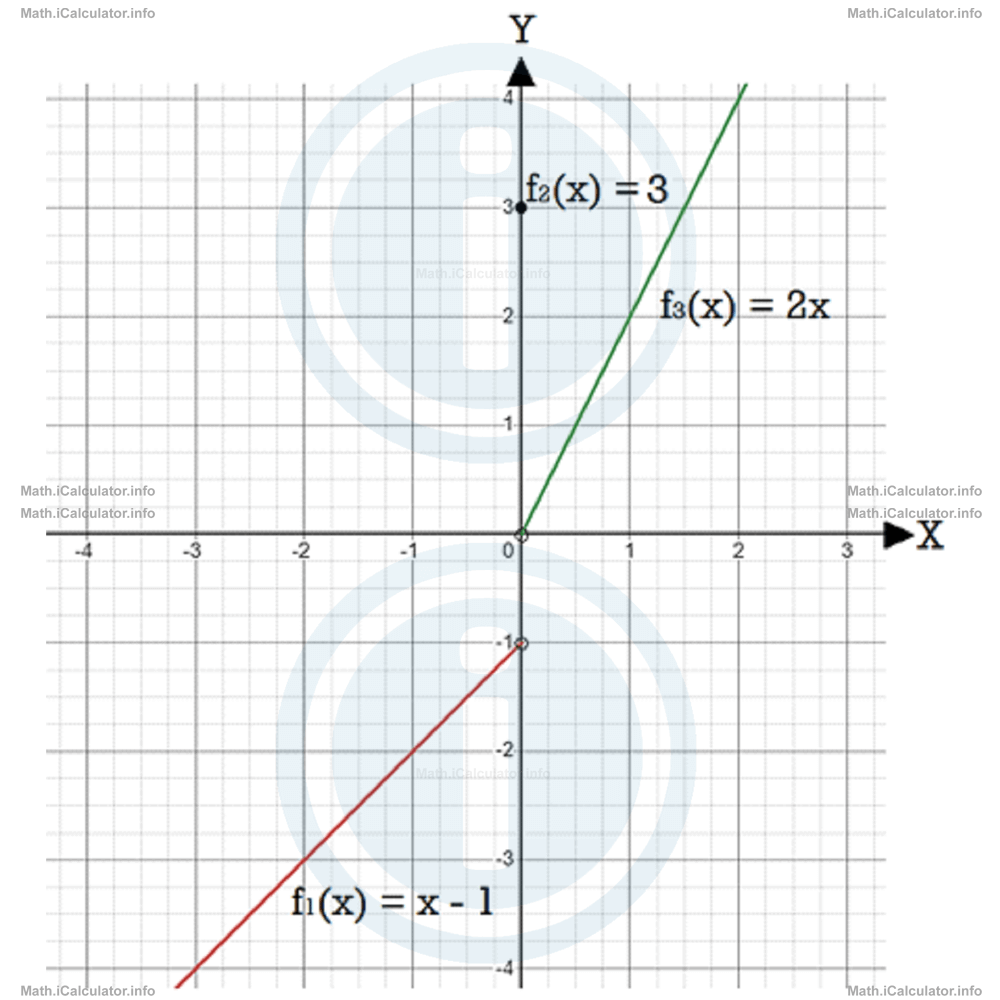Menu
Math Lesson 16.5.5 - Piecewise Functions with Constant Pieces
Please provide a rating, it takes seconds and helps us to keep this resource free for all to use
Welcome to our Math lesson on Piecewise Functions with Constant Pieces, this is the fifth lesson of our suite of math lessons covering the topic of Piecewise Functions, you can find links to the other lessons within this tutorial and access additional Math learning resources below this lesson.
Piecewise Functions with Constant Pieces
Some piecewise functions have no variable in one or more parts of them. This means that part of the graph is a constant function. The corresponding graph of that part is a horizontal line. All inputs in that part of the function give the same output, so we don't have to find the limit values, as all of them are the same.
Example 5
- Check the continuity of the function below at the limit points.f(x) = 3 - x x < 02 0 ≤ x < 32x - 4 x ≥ 3
- Plot the graph of this function.
Solution 5
- We have to check the continuity at two points: x = 0 and x = 3. At x = 0 we have to consider the upper and middle parts. Thus, for the upper part, we have f(x) = 3 - xand for the middle part, we have
f(0) = 3 - 0
= 3f(x) = 2Since 3 ≠ 2, this function is not continuous at x = 0.
f(0) = 2
At x = 3 we have to consider the middle and bottom parts. Thus, for the middle part, we havef(x) = 2and for the bottom part, we have
f(3) = 2f(x) = 2x - 4Since 2 = 2, this function is continuous at x = 3.
f(3) = 2 ∙ 3 - 4
= 6 - 4
= 2 - The graph is composed of three straight lines, two steep and one (the middle one) horizontal. The left part of a decreasing function as the gradient is negative (m = -1) while the right part is an increasing function as the gradient is positive (m = 2). Since the middle part is a constant function, its graph is horizontal (m = 0). The graph of this function is shown below.

Sometimes the constant piece is just a point. This occurs when the interval containing the constant piece is also a single point. Look at the following example.
Example 6
Check the continuity at the limit point and plot the graph of the piecewise function
Solution 6
- Since there is a single limit point (x = 0), we must check the continuity of the given function at this point only. The function is continuous at x = 0 if f(x) is equal in all three parts. Thus, the value of the function f(x) at x = 0 for the upper part is f1(0) = 0 - 1 = -1. As for the middle part, we have nothing to calculate as in this part f2(0) = 3. Last, the value of f(x) at x = 0 in the right part is f3(0) = 2 · 0 = 0. Therefore, we have f1(0) ≠ f2(0) ≠ f3(0), as -1 ≠ 3 ≠ 0. This means the function is not continuous at x = 0.
- The linear function of the upper part comes from negative infinity and ends at x = 0 without including this point. Hence, we write a blank dot at the right end (i.e. at x = 0) of the line representing this function. Likewise, the linear function on the right begins with a blank dot at x = 0, then it continues to the right up to infinity. Only the middle function is represented graphically through a filled dot at (0, 3). This point is not connected with the other two lines, as shown in the figure below.

You have reached the end of Math lesson 16.5.5 Piecewise Functions with Constant Pieces. There are 6 lessons in this physics tutorial covering Piecewise Functions, you can access all the lessons from this tutorial below.
More Piecewise Functions Lessons and Learning Resources
Whats next?
Enjoy the "Piecewise Functions with Constant Pieces" math lesson? People who liked the "Piecewise Functions lesson found the following resources useful:
- Constant Feedback. Helps other - Leave a rating for this constant (see below)
- Functions Math tutorial: Piecewise Functions. Read the Piecewise Functions math tutorial and build your math knowledge of Functions
- Functions Revision Notes: Piecewise Functions. Print the notes so you can revise the key points covered in the math tutorial for Piecewise Functions
- Functions Practice Questions: Piecewise Functions. Test and improve your knowledge of Piecewise Functions with example questins and answers
- Check your calculations for Functions questions with our excellent Functions calculators which contain full equations and calculations clearly displayed line by line. See the Functions Calculators by iCalculator™ below.
- Continuing learning functions - read our next math tutorial: Inverse Functions
Help others Learning Math just like you
Please provide a rating, it takes seconds and helps us to keep this resource free for all to use
We hope you found this Math tutorial "Piecewise Functions" useful. If you did it would be great if you could spare the time to rate this math tutorial (simply click on the number of stars that match your assessment of this math learning aide) and/or share on social media, this helps us identify popular tutorials and calculators and expand our free learning resources to support our users around the world have free access to expand their knowledge of math and other disciplines.